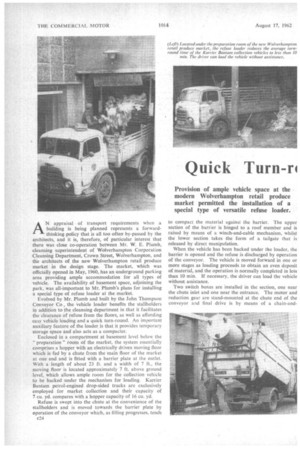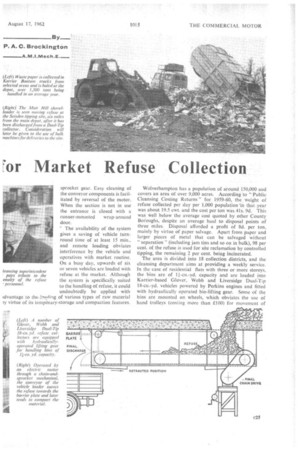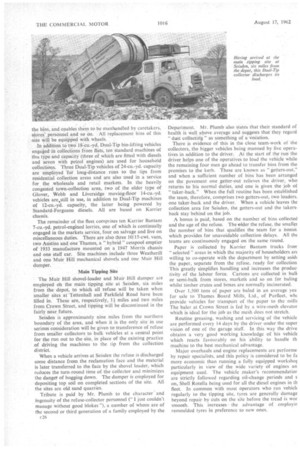Quick Turn-n or Market Refuse Collection
Page 54

Page 55

Page 56

If you've noticed an error in this article please click here to report it so we can fix it.
By_ P. A. C. Brockington
A IVI I IVIech.E.—
AN appraisal of transport requirements when a building is being planned represents a forwardthinking policy that is all too often by-passed by the architects, and it is, therefore, of particular interest that there was close co-operation between Mr. W. E. Plumb, cleansing superintendent of Wolverhampton Corporation Cleansing Department, Crown Street, Wolverhampton, and the architects of the new Wolverhampton retail produce market in the design stage. The market, which was officially opened in May, 1960, has an underground parking area providing ample accommodation for all types of vehicle. The availability of basement space, adjoining the park, was all-important to Mr. Plumb's plans for installing a special type of refuse loader at the market.
Evolved by Mr. Plumb and built by the John Thompson Conveyor Co, the Vehicle loader benefits the stallholders in addition to the cleansing department in that it facilitates the clearance of refuse from the floors, as well as affording easy vehicle loading and a quick turn-round. An important auxiliary feature of the loader is that it provides temporary storage space and also acts as a compacter.
Enclosed in a compartment at basement level below the preparation " room of the market, the system essentially comprises a hopper with an electrically driven moving floor which is fed by a chute from the main floor of the market at one end and is fitted with a barrier plate at the outlet. With a length of about 23 ft. and a width of 7 ft., the moving floor is located approximately 7 ft. above ground level, which allows ample room for the collection vehicle to be backed under the mechanism for loading. Karrier Bantam petrol-engined drop-sided trucks are exclusively employed for market collection and their capacity of 7 cu. yd. compares with a hopper capacity of 16 cu. yd.
Refuse is swept into the chute at the convenience of the stallhoiders and is moved towards the barrier plate by operation of the conveyor which, as filling progresses, tends c24 to compact the material against the barrier. The upper section of the barrier is hinged to a roof member and is raised by means of a winch-and-cable mechanism, whilst the lower section takes the form of a tailgate that is released by direct manipulation.
When the vehicle has been backed under the loader, the barrier is opened and the refuse is discharged by operation of the conveyor. The vehicle is moved forward in one or more stages as loading proceeds to obtain an even deposit of material, and the operation is normally completed in leis than 10 min. If necessary, the driver can load the vehicle without assistance.
Two switch boxes are installed in the section, one near the chute inlet and one near the entrance. The motor and reduction gear are stand-mounted at the chute end of the conveyor and final drive is by means of a chain-and sprocket gear, Easy cleaning of the conveyor components is facilitated by reversal of the motor. When the section is not in use the entrance is closed with a runner-mounted wrap-around door.
teansing superintendent pays tribute to the enuity of the refuse personnel.
" The availability of the system gives a saving of vehicle turnround time of at least 15 min., and remote loading obviates interference by the vehicle and operatives with market routine. On a busy day, upwards of six or seven vehicles are loaded with refuse at the market. Although the system is specifically suited to the handling of refuse, it could undoubtedly be applied with tdvantage to the !,)2(1ing of various types of raw material )y virtue of its temporary-storage and compaction features.
Wolverhampton has a population of around 150,000 and covers an area of over 9,000 acres. According to "Public Cleansing Costing Returns" for 1959-60, the .weight of refuse collected per day per 1,000 population 'in that year was about 19.5 cwt. and the cost per ton was 41s. 9d. This was Well below the average cost quoted by other County Boroughs, despite an average haul to disposal points of three miles. Disposal afforded a profit of 8d. per ton, mainly by virtue of paper salvage. Apart from paper and larger pieces of metal that can be salvaged without " separation " (including jam tins and so on in bulk), 98 per cent. of the refuse is used for site reclamation by controlled tipping, the remaining 2 per cent, being incinerated.
The area is divided into 18 collection districts, and the cleansing department aims at providing a weekly • service. In the case of residential fiats with three or more storeys, the bins are of 11-cu.-yd. capacity and are loaded into Karrier-based Glover, Webb and Liversidge Dual-Tip 18-cu.-yd. vehicles powered by Perkins engines and fitted with hydraulically operated bin-lifting gear. Some of the bins are mounted on wheels, which obviates the use of hand trolleys (costing more than /100) for movement of the bins, and enables them to be manhandled by caretakers, stores' personnel and so on. All replacement bins of this size will be equipped with wheels.
In addition to two 18-cu.-yd. Dual-Tip bin-lifting vehicles engaieci-in collections from flats, ten standard machines of this type and capacity (three Of _which are fitted with diesels and seven with petrol engines) are used for household collections Three Dual-Tip yehicles of 24-cu.-yd. capacity are emplbyed for long-distance runs to the tips from residential collection areas and are also used in a service for the wholesale and retail markets. In the heavily congested town-collection area, two of the older type of Glover, Webb and Liversidge moving-floor 14-cu.-yd. vehicles areastill in use, in addition to Dual-Tip machines of 12-cu.-yd. capacity, the latter being powered by Standard-Ferguson diesels. All are based on Karrier chassis.
The remainder of the fleet comprises ten Karrier Bantam 7-cu.-yd. petrol-engined lorries, one of which is continually engaged in the markets service, four on salvage and five on miscellaneous duties. There are also three 10/15-cwt. vans, two Auitins and one Thames, a " hybrid " cesspool emptier of 1933 manufacture mounted on a 1947 Morris chassis and one staff car.. Site machines include three Weatherill and one Muir -Hill mechanical shovels and one Muir Hill dumper.
Main Tipping Site The Muir Hill shovel-loader and Muir Hill dumper are employed ola the maintipping site at Seisden, six miles from the depot, to which all refuse will be taken when smaller sites arTettenhall and Parkfield Road have been filled in. These are, respectively, 14 miles and two miles from Crown Street, and tipping will be discontinued in the fairly near, future.
Seisden is approximately nine miles from the northern boundary of the area, and when it is the only site in use serious consideration will be given to transference of refuse from smaller collectors to bulk vehicles at a central point for the run out to the site, in place of the existing practice of driving the machines to the tip from the collection district.
When a vehicle arrives at Seisden the refuse is discharged some distance from the reclamation face and the material is later transferred to the face by the shovel loader, which reduces the turn-round time of the collector and minimizes the danger of bogging down. The dumper is employed for 'depositing top soil on completed sections of the site. All the sites are old sand quarries.
Tribute is paid by Mr. Plumb to the character and ingenuity of the refuse-collector personnel ("I just couldn't manage without good blokes "), a number of whom are of the second or third generation of a family employed by the c26 Department. Mr. Plumb also states that their standard of health is well above average and suggests that they regard "dust collecting" as something of a vocation.
There is evidence of this in the close team-work of the collectors, the bigger vehicles being manned by five operatives in addition to the driver. At the start of the run the driver helps one of the operatives to load the vehicle while
the remaining four men go ahead ff to transfer bins from the premises to the kerb. These are known as "getters-out,"
and when a sufficient number of bins has been arranged on the pavement one getter-out relieves the driver, who returns to his normal duties, and one is given the job of taker-back." When the full routine has been established the team, therefore, comprises two getters-out, two loaders, one taker-back and the driver. When a vehicle leaves the collection area for Seisden, the getters-out and the takers back stay behind on the job.
A bonus is paid, based on the number of bins collected and the age of the refuse. The elder the refuse, the smaller the number of bins that qualifies the team for a bonus which provides for unavoidable collection delays. All thf teams are continuously engaged on the same round.
Paper is collected by Karrier Bantam trucks frorr " selected " areas in which the majority of householders art willing to co-operate with the department by setting aside the paper, separate from the refuse, ready for collection This greatly simplifies handling and increases the produc tivity of the labour force. Cartons are collected in bull or semi-bulk from stores, market's and so on for baling whilst timber crates and boxes are normally incinerated.
Over 1,500 tons of paper are baled in an average yea for sale to Thames Board Mills, Ltd., of Purfleet, wh provide vehicles for transport of the paper to the mills The baler at Crown Street is fed by a wire-mesh elevator which is ideal for the job as the mesh does not stretch.
Routine greasing, washing and servicing of the vehicle are performed every 14 days by the driver under the super vision of one of the garage staff. In this way the drive obtains a very good working knowledge of his vehicle which reacts favourably on his ability to handle th machine to the best mechanical advantage.
Major overhauls and engine replacements are performe by repair specialists, and this policy is considered to be fa more economic than running a fully equipped workshoi particularly in view of the wide variety of engines an equipment used The vehicle ,maker's recommenclatior are strictly followed regarding oil-change periods and s on, Shell Rotella being used for all the diesel engines in th fleet. In common with most operators who run vehicle regularly to the tipping site, tyres are generally damage beyond repair by cuts on the site before the tread is wor smooth. This increases the advantage of employir remoulded tyres in preference to new ones.












































































































